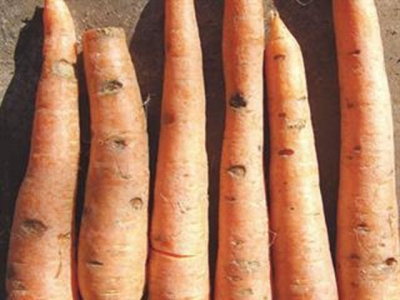Getting to the bottom of cavity spot mysteries

Cavity Spot is a very destructive carrot disease that has been giving farmers and researchers sleepless nights all over the world. It has been determined that cavity spots on carrots are caused by the soil fungus Pythium.
Typical cavity spot symptoms. Photo: Bill Kerr
Two species are the most common culprits – P. sulcatum and P. violae, each of which can be dominant in different areas. It’s suspected that other species play a more minor role.
Pythium gave researchers trying to identify the culprit headaches for decades, because it grows very slowly on agar plates in the laboratory and other species tend to take over.
Pythium is part of the damping-off complex. When we used to make our own seedlings in the soil, before the advent of cavity seedlings, damping off always started on the compact or sunken areas on the seedbeds where water stood. This fungus likes cool, wet conditions with low oxygen. It is not an anaerobic organism but does favour conditions approaching this state.
This is why cavity spot is worse in the cooler parts of the year and after heavy downpours. Farmers often prepare wet soil in late summer, when they reach a planting deadline, promoting the disease. Deep, thorough cultivation provides poor conditions for Pythium, but if this is followed by a heavy rain, the soil conditions can become favourable for it.
The disease is sporadic since it requires specific soil conditions. In a heavily infested soil, minimum damage may occur one year and a disaster the next. Crop rotation is advised but only in desperation, as the fungus produces very hard spores that can last for years. Pythium can build up on crops and weeds without showing symptoms.
Even a light infestation of spores does a lot of damage when conditions are favourable. Crop spraying has mixed results, and the two common pathogens respond differently.
Certain lands are more prone to the disease, and this is likely to be due to soil conditions rather than a greater infestation of spores. These lands should rather be used in summer when the disease is less active.
A farmer’s best weapons are looking after the soil by maintaining the organic content, and paying attention to soil structure.
Related news
Tools

Phối trộn thức ăn chăn nuôi

Pha dung dịch thủy canh

Định mức cho tôm ăn

Phối trộn phân bón NPK

Xác định tỷ lệ tôm sống

Chuyển đổi đơn vị phân bón

Xác định công suất sục khí

Chuyển đổi đơn vị tôm

Tính diện tích nhà kính

Tính thể tích ao



 Getting it right with sweet potatoes
Getting it right with sweet potatoes  No-till can be practical for vegetables
No-till can be practical for vegetables